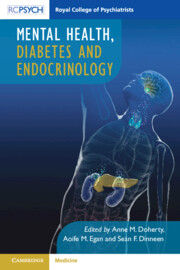Book contents
- Mental Health, Diabetes and Endocrinology
- Mental Health, Diabetes and Endocrinology
- Copyright page
- Contents
- Contributors
- Preface
- Chapter 1 An Introduction to Psychiatry in Endocrinology
- Chapter 2 Depression across Endocrine Disorders
- Chapter 3 Antipsychotic Medications and Metabolic Syndrome
- Chapter 4 ‘Diabulimia’, Diabetes and Eating Disorders
- Chapter 5 Disorders of the Hypothalamic–Pituitary–Adrenal Axis
- Chapter 6 Disorders of the Thyroid and Parathyroid
- Chapter 7 Psychological Factors Impacting on Endocrine Disorders and Self-Management and Medication-Taking Behaviour
- Chapter 8 Cognitive Impairment and Endocrine Conditions
- Chapter 9 Suicidal Ideation and Self-Harm
- Chapter 10 Obesity and Mental Health
- Chapter 11 Gender Incongruence
- Chapter 12 Anti-androgens in Forensic Psychiatric Settings
- Chapter 13 Service- and Setting-Related Challenges
- Index
- References
Chapter 9 - Suicidal Ideation and Self-Harm
Published online by Cambridge University Press: 14 October 2021
- Mental Health, Diabetes and Endocrinology
- Mental Health, Diabetes and Endocrinology
- Copyright page
- Contents
- Contributors
- Preface
- Chapter 1 An Introduction to Psychiatry in Endocrinology
- Chapter 2 Depression across Endocrine Disorders
- Chapter 3 Antipsychotic Medications and Metabolic Syndrome
- Chapter 4 ‘Diabulimia’, Diabetes and Eating Disorders
- Chapter 5 Disorders of the Hypothalamic–Pituitary–Adrenal Axis
- Chapter 6 Disorders of the Thyroid and Parathyroid
- Chapter 7 Psychological Factors Impacting on Endocrine Disorders and Self-Management and Medication-Taking Behaviour
- Chapter 8 Cognitive Impairment and Endocrine Conditions
- Chapter 9 Suicidal Ideation and Self-Harm
- Chapter 10 Obesity and Mental Health
- Chapter 11 Gender Incongruence
- Chapter 12 Anti-androgens in Forensic Psychiatric Settings
- Chapter 13 Service- and Setting-Related Challenges
- Index
- References
Summary
Suicide is a leading cause of death in many Western countries. Suicidal ideation and behaviours can be symptoms of depression, but they are also seen in people with other mental health problems, such as bipolar affective disorder, psychosis, substance abuse disorders and adjustment disorders. They are also seen in people who present with psychological distress rather than any diagnosable mental disorder. The consequences of suicidal acts may be especially serious in people with diabetes given the accessibility of lethal means on the one hand, but also the heightened risk of developing complications in cases of severe self-neglect due to a more passive death wish on the other. In Chapter 2, we discussed the relationship between depression and endocrine disorders. Although depression is associated with suicidal ideations and behaviours, it will be these symptoms rather than a diagnosis of mood disorder that are the focus of this chapter.
- Type
- Chapter
- Information
- Mental Health, Diabetes and Endocrinology , pp. 95 - 105Publisher: Cambridge University PressPrint publication year: 2021



